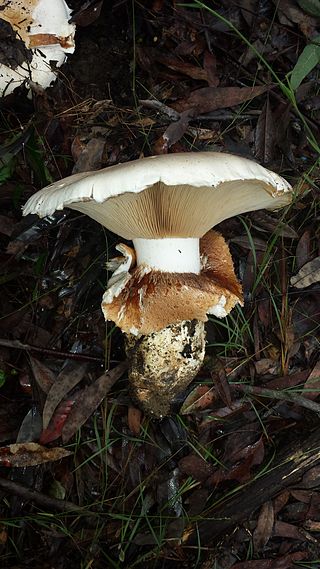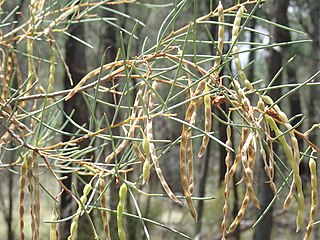
Acacia baileyana or Cootamundra wattle is a shrub or tree in the flowering plant family Fabaceae. The scientific name of the species honours the botanist Frederick Manson Bailey. It is indigenous to a very small area in southern inland New South Wales, comprising Temora, Cootamundra, Stockinbingal and Bethungra districts. However, it has been widely planted in other Australian states and territories. In many areas of Victoria, it has become naturalised and is regarded as a weed, outcompeting indigenous Victorian species.

Acacia cultriformis, known as the knife-leaf wattle, dogtooth wattle, half-moon wattle or golden-glow wattle, is a perennial tree or shrub of the genus Acacia native to Australia. It is widely cultivated, and has been found to have naturalised in Asia, Africa, North America, New Zealand and South America. A. cultriformis grows to a height of about 4 m (13 ft) and has triangle-shaped phyllodes. The yellow flowers appear from August to November in its natural range. Its attractive foliage and bright flowers make it a popular garden plant.

Acacia pycnantha, most commonly known as the golden wattle, is a tree of the family Fabaceae. It grows to a height of 8 metres and has phyllodes instead of true leaves. The profuse fragrant, golden flowers appear in late winter and spring, followed by long seed pods. Explorer Thomas Mitchell collected the type specimen, from which George Bentham wrote the species description in 1842. The species is native to southeastern Australia as an understorey plant in eucalyptus forest. Plants are cross-pollinated by several species of honeyeater and thornbill, which visit nectaries on the phyllodes and brush against flowers, transferring pollen between them.

Acacia saligna, commonly known by various names including coojong, golden wreath wattle, orange wattle, blue-leafed wattle, Western Australian golden wattle, and, in Africa, Port Jackson willow, is a small tree in the family Fabaceae. Native to Australia, it is widely distributed throughout the south west corner of Western Australia, extending north as far as the Murchison River, and east to Israelite Bay. The Noongar peoples know the tree as Cujong.

Acacia decurrens, commonly known as black wattle or early green wattle, is a perennial tree or shrub native to eastern New South Wales, including Sydney, the Greater Blue Mountains Area, the Hunter Region, and south west to the Australian Capital Territory. It grows to a height of 2–15 m (7–50 ft) and it flowers from July to September.

Omphalotus nidiformis, or ghost fungus, is a gilled basidiomycete mushroom most notable for its bioluminescent properties. It is known to be found primarily in southern Australia and Tasmania, but was reported from India in 2012 and 2018. The fan or funnel shaped fruit bodies are up to 30 cm (12 in) across, with cream-coloured caps overlain with shades of orange, brown, purple, or bluish-black. The white or cream gills run down the length of the stipe, which is up to 8 cm (3 in) long and tapers in thickness to the base. The fungus is both saprotrophic and parasitic, and its fruit bodies are generally found growing in overlapping clusters on a wide variety of dead or dying trees.

Acacia myrtifolia, known colloquially as myrtle wattle, red stem wattle or red-stemmed wattle, is a species of Acacia native to coastal areas of southern and eastern Australia.

Cortinarius rotundisporus, also known as the elegant blue webcap, is a basidiomycete mushroom of the genus Cortinarius found in southern Australia, where it is found in eucalypt forests and rainforests. The cap of the fruit body is a steely blue colour, with a yellowish boss, and paler similarly coloured stipe.

Marasmius elegans, commonly known as the velvet parachute, is a species of fungus in the family Marasmiaceae. It has a reddish-brown cap, and a whitish stipe with white hairs at the base. It can be found in eucalypt forests in Australia.

Pholiota communis is a species of fungus in the family Strophariaceae. It is found in Southeastern Australia. The small brown mushrooms appear in leaf litter of pines and eucalypts in autumn and winter.

Acacia filicifolia, commonly known as fern-leaved wattle, is a plant in the legume family, Fabaceae and is native to eastern Australia. It is a shrub or tree with compound leaves resembling fern fronds, and spherical heads of yellow or bright yellow flowers from autumn to late spring. It is a common and widespread species, especially on the coast and tablelands of New South Wales.

Cuphophyllus cheelii is a species of fungus in the family Cantharellaceae. First described in 1919 by botanists John Burton Cleland and Edwin Cheel, the fungus is found in Australia.
Russula erumpens is a species of fungus in the family Russulaceae. It is found in Australia, where it occurs in eucalypt forests and woodlands.

Tubaria rufofulva is a species of agaric fungus in the family Tubariaceae. Found in Australia, it was originally described in 1927 by John Burton Cleland as a species of Pholiota. The fungus was transferred to the genus Tubaria in 1983.

Austrocortinarius australiensis, commonly known as the skirt webcap, is a species of mushroom in the family Cortinariaceae which is native to Australia and New Zealand. The white mushrooms appear in autumn and can grow very large, with their caps reaching 30 cm (12 in) in diameter.

Acacia dawsonii, also known as Dawson's wattle or poverty wattle or mitta wattle, is a shrub of the genus Acacia and the subgenus Plurinerves found along parts of the east coast of Australia

Acacia havilandiorum, also known as Haviland's wattle or needle wattle, is a shrub of the genus Acacia and the subgenus Plurinerves. It is native to areas in South Australia, New South Wales and Victoria.

Acacia sericophylla is a shrub or tree commonly known as the desert dogwood, desert oak or cork-bark wattle. To the Indigenous Australian people of the Pilbara, the Nyangumarta peoples, it is known as Pirrkala. The species is of the genus Acacia and the subgenus Plurinerves.

Acacia cheelii, commonly known as motherumbah or motherumbung, is a tree belonging to the genus Acacia and the subgenus Juliflorae that is native to eastern Australia.

Daniel McAlpine was a Scottish-born Australian mycologist known for his research in plant pathology. He wrote several publications on plant disease in many crops and other plants. McAlpine was a lecturer in biology at the University of Melbourne from 1884, and, with his appointment to the Victorian Department of Agriculture from 1890 to 1911, became the British Empire's first professional plant pathologist.


















